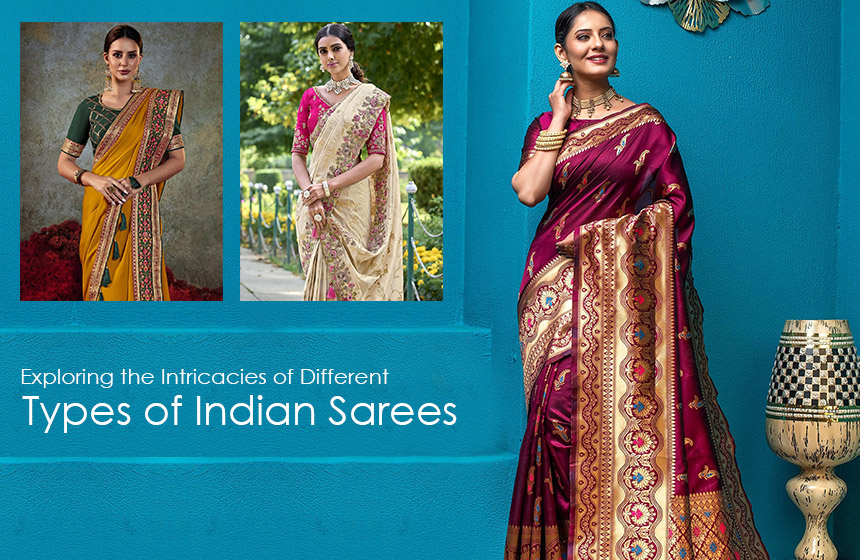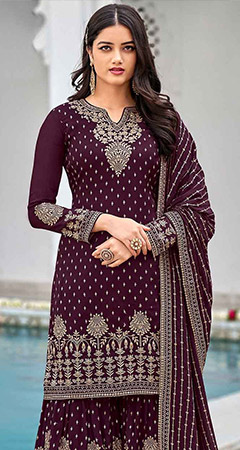The beauty of sarees goes beyond being just clothing, don't you think? These sarees are a blend of tradition, culture, and diversity, representing our country's heritage. In this blog, we will delve into the types of sarees, celebrating how they have evolved over time and their cultural importance in different regions. To start our exploration let us take a trip back in time to uncover the origins of sarees.
It's fascinating to observe how different regions and ruling dynasties have influenced and shaped the saree as we know it today. We have witnessed styles evolving and adapting to embrace both tradition and modernity in the changing world of fashion. Sarees not only serve as garments. Also symbolize femininity, gracefulness and elegance during festivals and special occasions. Are you ready to embark on a journey through India by exploring its sarees? Join us as we celebrate the diversity they represent.
The Cultural Significance of Traditional Sarees Across Various Regions in India. Indian Saree hold a significance that extends far beyond their aesthetic appeal. They capture the essence of each region, within Indian subcontinent reflecting its nature.
In this segment of our blog, we will discuss types of sarees that originate from parts of India.
North Indian Sarees
Let's begin this adventure with the North Indian sarees, where we will discuss the beauty of Banarasi and Chanderi sarees.
• Banarasi Sarees
The origin of Banarasi sarees can be traced back to the city of Varanasi, where this exquisite weaving art has thrived for centuries. Delving into the weaving techniques ranging from brocades to Tanchoi reveals the vivid range of Banarasi sarees. Each piece becomes a testament to craftsmanship representing the cultural heritage of the region.
• Chanderi Sarees
Exhibiting elegance while being lightweight, Chanderi sarees transport us to the heartland of Madhya Pradesh. Shedding light on their characteristics and cultural legacy unravels the diverse array within the Chanderi saree family. These garments transcend fabric; they embody tradition and artistic expression.
East Indian Sarees
Venturing towards East India introduces us to sarees that narrate tales of tradition and artistic brilliance such as Taant, Sambalpuri and Baluchari sarees.
• Taant SareesBengal's traditional handwoven cotton saree variety, known as Taant, holds a rich background. Tracing its roots allows us to explore its defining features, encompassing fabric choices and textures that make Taant saree stand out. Taant sarees are known for their designs and colour combinations.
• Sambalpuri SareesMoving on to Sambalpuri sarees, these creations hail from Odisha. Showcase the art of tie-dye. Each Sambalpuri saree is a one-of-a-kind masterpiece thanks to its dyeing techniques and intricate motifs.
• Baluchari Sarees
We are fascinated by the heritage and historical significance associated with these sarees, appreciating both the meticulous weaving process and the luxurious silk used in their creation. The inclusion of historical narratives in Baluchari sarees adds a layer to their irresistible charm.
West Indian Sarees
Moving towards the western part of India, we encounter a colourful display of artistic diversity through Bandhani, Paithani and Leheriya sarees.
Lets delve into the captivating world of Bandhani sarees, where the art of tie dye unfolds. These sarees, from Gujarat and Rajasthan are a reflection of their history and intricate craftsmanship. Each Bandhani saree tells a story through its colors and mesmerizing patterns making it a canvas for self expression.
Now, let us shift our focus to Paithani sarees, exploring their significance and historical roots. These exquisite creations from Maharashtra showcase the mastery of silk weaving techniques and intricate motifs that add to their beauty. They truly represent the fabric of Maharashtra.
Moving on to Leheriya sarees, we celebrate their tie dye techniques that create patterns and vibrant colors. Originating from Rajasthan and Gujarat these sarees hold a place in the hearts of people as they symbolize identity beyond being mere garments.
South Indian Sarees
As we venture South, we encounter the timeless elegance of Kanjeevarams, Mysore silks and Kasavu sarees. Each one exudes its charm that captivates all who lay eyes upon them.
• Kanjeevaram sarees

Kanjeevaram sarees are adorned with motifs, borders and selected color palettes that make them truly exceptional works of art. These sarees hold importance during weddings and special events. They serve as a means to celebrate the culture of the South and its opulent silk fabrics.
• Mysore Silk Sarees
Mysore Silk sarees are renowned for their high silk quality and meticulous weaving methods. We acknowledge the traditions and occasions where Mysore Silk sarees are cherished. These sarees serve as a living testament carrying forward Karnataka's legacy.
• Kasavu Sarees
Our journey concludes in Kerala, where Kasavu sarees hold rooted importance. By delving into their heritage and symbolic significance, we immerse ourselves in the weaving process with borders. Exploring their popularity during occasions and attire combinations, in Kerala's tapestry of culture, we recognize Kasavu sarees as timeless classics.
Indian sarees surpass garments; they embody tradition and artistry while creating a mesmerizing tapestry of diversity that truly captivates us. As we come to the end of this journey, let's pause for a moment and marvel at the array of colours, intricate designs and captivating narratives that have woven Indian sarees into the very fabric of our cultural heritage. If you are feeling a strong urge to buy a new saree after reading this blog, Parivar Ceremony has got you covered. Visit our online store and find yourself a beautiful regional Indian saree.





